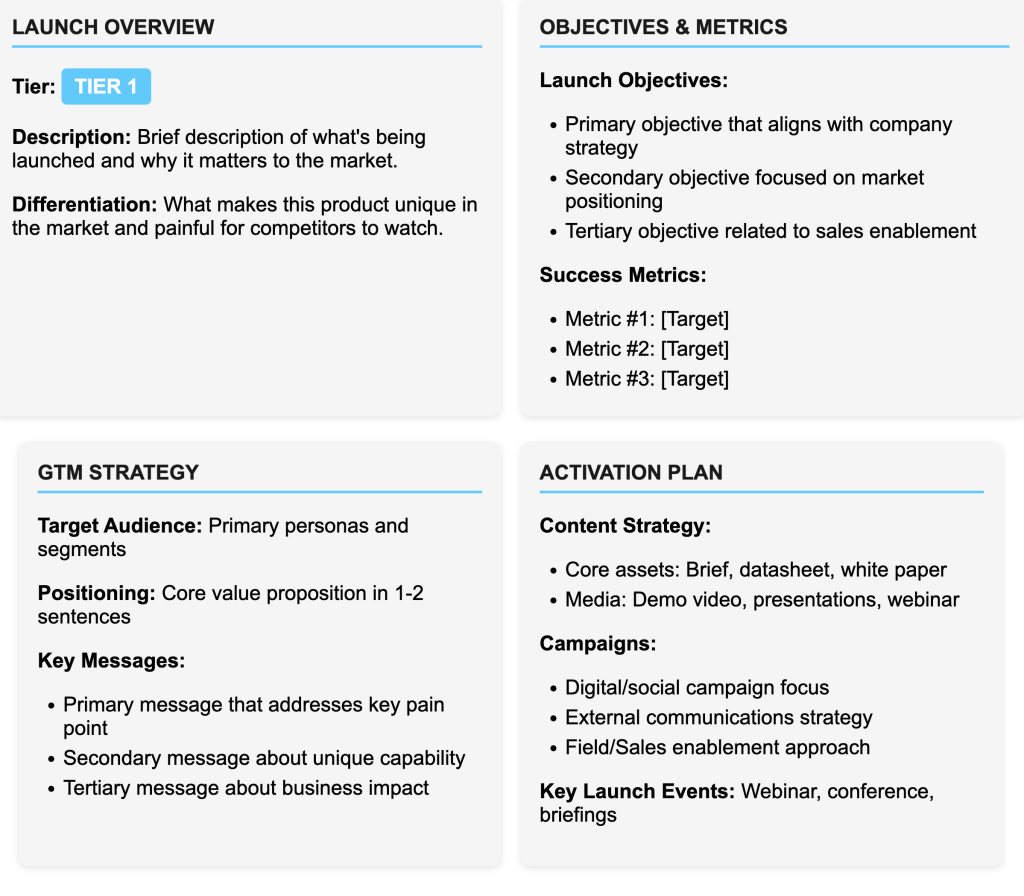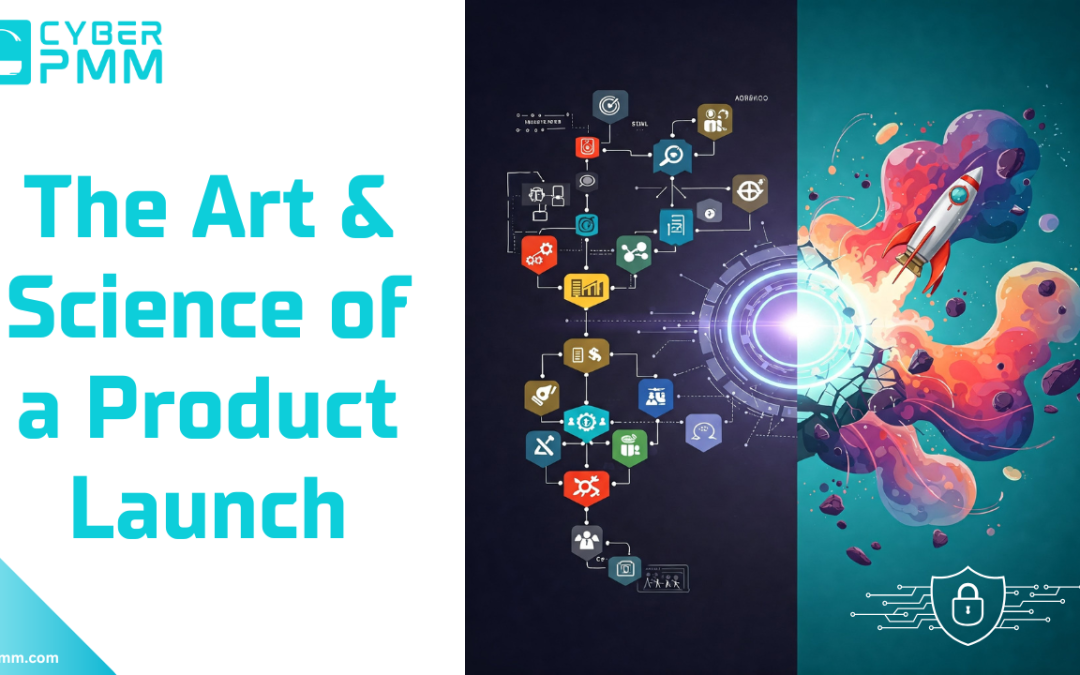When everyone’s looking at you to deliver magic on product launch day, what actually matters?
And how do you stay sane when ~50% (or more?) of product launches miss the GA date?
I’ve survived dozens of product launches across my career—some triumphant, others that I’ve erased from my memory. Through the victories and the “learning experiences,” I’ve discovered something crucial: there’s a method to the madness, but it’s not what most launch playbooks will tell you.
The Truth About Product Launches
Let’s start with an uncomfortable reality: not all products we launch are actually worth the effort. (Yes, I said it.) A Harvard professor, Clayton Christensen says, “Nearly 30,000 new products are introduced each year, and 95% of them fail.” Ouch. But every PMM reading this knows it’s kinda accurate. I don’t know how many of these are tech/cyber products, but it just illustrates the point, and it also makes me look smart by referencing Harvard.
“Nearly 30,000 new products are introduced each year, and 95% of them fail.”

Half the battle of a successful product launch starts with having a product that works, offers some innovation, and might actually be adopted by a predefined target audience. Some might argue great products market themselves—look at McKinsey’s model of minimal advertising, or Sony’s PlayStation 5 with demand so high they couldn’t keep up with production. Who needs PMM, right?
But for those of us in cybersecurity who don’t have the luxury of launching the next PS5, we need to guide and help our product and engineering friends bring products to market.
The Product Launch Requirements You Need to Succeed with Speed, Indeed (I like to rhyme)
I’ve seen it all: wildly over-engineered processes with enough checkboxes to make your eyes bleed, and dangerously simplified approaches that ignore cross-functional alignment entirely. And I fully appreciate that this might be over the top if you are a solo PMM in a small startup, so let’s assume that this is for vendors that are somewhere in the middle, in terms of having some complexity in the org chart. Assuming that’s true, here are five non-negotiables:
1. Find an Executive Sponsor
Self-explanatory. Without someone upstairs who cares (rhyming again), the launch will fail.
2. Temper Expectations with a A Clear Product Launch Tier & GA Date
Before you get sucked into launch meetings, there needs to be a Launch Tiering Gate that considers revenue impact, regional availability, and strategic alignment. A Tier should be assigned to any launch that you are asked to support prior to PMM involvement. Feel free to refuse participating in launch activity discussions until this process is complete. If you get pushback, tell them Cyber PMM said it was necessary and send them my way and I’ll back you up.
Product Launch Tier Definitions – PMM Viewpoint
| Criteria | Tier 1 | Tier 2 | Tier 3 | Tier “Get Outta Here” |
|---|---|---|---|---|
| Market Impact | Very Significant greatly impacts customer acquisition, revenue, market entry and retention | Moderate at least one exciting feature, impacts revenue growth, market expansion | Low necessary for UX but mostly “catch-up” features that we won’t brag about | Maintenance “Meh” release only engineering and very small subset of users care about |
| PMM Entry Point Prior to General Availability | 90 days | 60 days | 30 days | No PMM involvement |
| Competitive Differentiation | Significant painful for competitors to watch | Moderate some competitors have it, others don’t | Low most competitors already have it | None table stakes |
| PMM Support Level (What % of available tools we deploy) | Significant – 100% deploy full PMM toolkit across external and internal levers that you can pull | Moderate – 60% some market-facing activities, some internal enablement and comms | Low – 25% basic awareness, some content updates, limited internal comms | None – 0% nope, sorry – we have bigger fish to fry |
| Budget Requirements | Significant | Moderate | Low | None |
Don’t be afraid to refuse participation until this tier is defined. Without this, at least for companies a bit larger, you will be spinning your tires and burning calories. Your time is valuable, and not all launches deserve equal attention.
3. Assign a Dedicated Product Launch Manager (Project Manager/Program Manager)
This isn’t you. I repeat, do not become a product launch manager tracking someone else’s work. At least for somewhat more mature vendors, this is a project manager whose sole job is managing the cross-functional chaos with a proper project plan. There are professionals trained to do this, and it ain’t you. They host the calls, record the calls, take the notes, track progress across functions, and communicate risks that might impact your GA date. They are responsible for escalating to executive sponsors and communicating status.
But you can still be a good collaborator. Provide your input into what you will be responsible for, based on the Launch Tier. Many times, I have told a project manager, “No, I’m not doing that for this launch.” and they honestly don’t care, because you are the expert, not them. Take authority over the PMM tasks involved instead of just being handed an outdated project plan from three years ago. Update and adapt based on your toolkit.
Without this role, you’ll become the de facto product launch manager while still being expected to deliver all your marketing work. That’s a recipe for burnout.

4. There Better Be a Committed Product Manager
Critical. You need a visible, competent and engaged PM partner who can reassure you that engineering can actually deliver the product that you are about to promise the world. They should provide a solid Product Requirements Document (PRD) or internal page, detailing the research and logic behind the product strategy. Without this, you’re marketing on quicksand and frankly not being taken seriously by the business.
There’s nothing worse than being handed a product launch without knowing the background. That means you’re just an “order taker” for the PM, and that’s not cool.
The PM also is in a tough spot, because they are usually not actually doing the building. They are just asking Engineering for status updates, and honestly relaying information as a middle-person. Good PMs will run a tight ship, and have a good alignment with Engineering, but we all know that’s a rare case and not the norm. On the flip side, the best product launches I’ve ever been involved in have had solid PM’s in place.
5. Create a Clear Marketing RACI Matrix to Avoid Stepping on Toes
Who in Marketing is Responsible, Accountable, Consulted, or merely Informed for every action? If this isn’t crystal clear, you’ll end up being the catch-all for everything from press releases to sales training. You may need CMO level air cover for this document. The bigger your organization, the more complex this gets, and the more you will need a CMO-blessed RACI.
A RACI can be linked from a product launch manager’s overall plan, within the Marketing section but there should be line items with names that aren’t your own. And you should make sure everyone is held accountable for the launch and that you aren’t speaking for others’ lack of presence. I’ve seen this countless times, where PMM’s get stuck between other marketing functions and the business, and we get in the way. Just cut to the chase – connect the Project Manager with every other functional lead based on a RACI directly.
If any of these components are missing, escalate immediately. Express hesitation about committing your time to something that doesn’t have the foundation for success.
From Framework to Reality
Let’s say the stars align and you have all five components. Now what?
First, scrutinize every line item in the project plan that lists Product Marketing as the owner. I’ve seen too many PLMs copy-paste entire project plans from previous launches without considering what’s actually needed this time. Schedule a one-on-one with the Launch Manager to give your take.
This early feedback is critical because Marketing is often viewed as a bystander in the launch tiering process. Our vote isn’t given the weight it deserves.
Here’s why this matters: Early in the process, there might not be activities assigned to your GTM peers. But wait 2-4 weeks, and suddenly you’ll hear: “Where are we at with the press release?” Everyone will look to you because, hey, you’re “Marketing.”
Your Secret Weapon: The Launch Plan-on-a-Page (POAP, sounds like “nope”)
To drive alignment across teams, create a launch Plan-on-a-Page (or, POAP). This one-slide summary includes:
- Launch tier
- Description of what’s being launched
- Differentiation
- Launch objectives
- Metrics for success
- Timeline
- GTM strategy
- Activation plans

You can just invent your own based on the data you have available. This compact view helps socialize your launch objectives across the organization and gives you ammo in case you’re asked to present to executives. Keep it updated as realities shift—because they will. Oh and people love timelines, highly recommend using a timeline of activities on top of the slide.
The GA Date Myth
Here’s some bitter truth from the trenches: of the 40+ Tier 1/2 launches I’ve managed, at least 65% missed their original GA date (not science, just my guesstimate in 12 years of doing this). Gartner has a report from 2019 that says it’s “45%”, and that might be true, but I think it’s higher. It’s practically a law of PMM-ing that Product & Engineering teams are terrible at predicting ship dates.
My approach now? Tempered optimism. I’ll join the process as a team player, but I’m cautious about rallying GTM teams too early because I know delays are likely. That said, always be prepared for the rare on-time scenario—you don’t want to be the PMM that misses a GA date that actually happens. So it’s a tightrope.
In practice, this means submitting that web page deployment ticket for the projected GA date, but following up with a Slack message letting the team know you’ll update them on any “potential shifts”. This is a stealthy way to communicate your skepticism without sinking the ship. You’re a risk manager, keeping your ear to the ground with the product team and being first to communicate any date changes to your GTM peers.
Launch Activities That Actually Matter
For a Tier 1 launch, here’s what should be on your radar and each subsequent tier gradually erases items as you go:
Launch Activities by Tier
| Activity | Tier 1 | Tier 2 | Tier 3 |
|---|---|---|---|
| Strategy & Research | |||
| Market research and competitive analysis | ✓ | ||
| Brief industry analysts and incorporate their feedback | ✓ | ||
| Share your POAP with marketing peers | ✓ | ||
| Document updates to the Buyer’s Journey content mix | ✓ | ✓ | |
| Core Content Development | |||
| Publish/Update a Product Messaging Brief (PMB) | ✓ | ✓ | ✓ |
| Create product brief/data sheet | ✓ | ✓ | |
| Create a white paper | ✓ | ||
| Secure official screenshots and product visual assets | ✓ | ✓ | ✓ |
| Write community blog post | ✓ | ✓ | |
| Write executive blog post | ✓ | ||
| Fact-check press release language | ✓ | ||
| Digital & Web | |||
| Update or create product web pages | ✓ | ✓ | |
| Produce demo videos/Navattics with use cases | ✓ | ✓ | |
| Create social media assets | ✓ | ||
| Create 30-second hype video | ✓ | ||
| Sales & Field Enablement | |||
| Update field enablement resources and pages | ✓ | ✓ | |
| Present on sales enablement calls | ✓ | ✓ | |
| Enable keynote presentations | ✓ | ||
| Customer & Analyst Relations | |||
| Secure and publish customer testimonials | ✓ | ✓ | |
| Publish sponsored analyst content | ✓ | ||
| Events & Communications | |||
| Plan webinars with your PM | ✓ | ||
| Coordinate internal communications | ✓ | ✓ | ✓ |
| Coordinate external communications | ✓ |
This isn’t everything, but it’s a baseline. Each launch will be unique, so develop your own plan and be realistic about your bandwidth. Oh and take it from me, plan your PTO after the launch is truly done, don’t depend on a GA date for personal plans because it will change.
The Bottom Line
Launching products is a PMM superpower, but it requires planning, coordination, and cross-functional diplomacy. You’re the glue that holds the launch together, and communication is your greatest asset.
The real value you bring isn’t just checking boxes on a launch plan, it’s bringing market research upfront and validating strategic launch plans with market expertise. That’s how you transform a product release into a market event worth talking about. And the other key – don’t pin your hopes and dreams on GA dates, there is an increasing probability they will be missed, so reduce the heartburn by being adaptable.
There’s no exact science to a successful launch, but there are ways to increase the probability of success–and that’s the art.
What’s been your experience with product launches? Drop a comment below or message me directly—I’d love to hear your war stories.
References:
- https://www.gartner.com/en/newsroom/press-releases/2019-09-09-gartner-survey-finds-that-45-percent-of-product-launches-are-delayed-by-at-least-one-month
- https://professionalprograms.mit.edu/blog/design/why-95-of-new-products-miss-the-mark-and-how-yours-can-avoid-the-same-fate/
⤵️ Join the conversation with 300+ other Cyber PMMs
- Subscribe to the newsletter on LinkedIn or Substack. (You can also subscribe directly below.)
- Follow Cyber PMM and/or me on LinkedIn.
- Subscribe to the YouTube channel.
- Subscribe to the Podcast on Spotify or Apple.
- Follow on X and @Cyber_PMM on Instagram.


